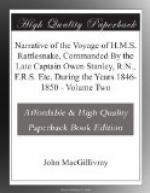Here Mr. Kemp, a schoolmaster of the Church Mission Society, has been located for upwards of thirty years. A well built store, a neat cottage and garden, and residences for a few Maoris, complete the establishment. From this place a dray-road leads to the extensive Missionary establishment at Waimate, distant about ten miles. Crossing the river, we started for the falls, in charge of a sharp little urchin who acted as guide. After leaving the narrow valley which the river has cut for itself through a superstratum of yellowish clay, the country becomes nearly level—a dreary plain, covered with fern and the manuka bush. The extensive tract of country now in sight is said to have once been a great kauri forest—a few of these noble trees (Dammara australis) were pointed out to me from a distance. When about halfway we left the road, and within the distance of a mile our guide contrived to lead us into five or six bogs, where we were up to our knees in water, besides entangling us in several thickets nearly as bad to penetrate as an Australian scrub. At length we arrived in sight of the waterfall, then in full force from the quantity of rain which had lately fallen.
The Keri-Keri, after a long course through a country composed chiefly of upland moors and gently undulating hills, here suddenly precipitates itself over a rocky wall into a large circular pool eighty feet below, then continues its course for a while between steep and densely wooded banks. Behind the fall the rock is hollowed out into a wide and deeply arched cave, formed by the falling out of masses of columnar rock. A winding path leads to the foot of the fall, whence the view is very grand. Some of the party crept over the slippery rocks, and reached the cave behind the fall, where they were much gratified with the novelty of the scene. The luxuriant and varied vegetation in the ravine affords a fine field for the botanist. The variety of cryptogamic plants is very great—every rock, and the trunk of each tree, being covered with ferns, lichens, and mosses. Among the trees I noticed the pale scarlet flowers of the puriri or New Zealand Teak (Vitex littoralis) the hardest* and most durable of all the woods of the country. A short search among the damp stones and moss brought to light some small but interesting landshells, consisting of a pupiform Cyclostoma, a Carocolla, and five species of Helix. This leads me to mention, that although the number of New Zealand landshells hitherto described scarcely exceeds a dozen, this does not imply any scarcity of such objects in the country, as an industrious collector from Sydney, who spent nine months on the northern and middle islands, obtained nearly a hundred species of terrestrial and fluviatile mollusca. The scarcity of birds during our walk surprised me, for the only one which I saw on shore was a solitary kingfisher (Halcyon vagans): during our ascent of the Keri-Keri, however, many ducks (Anas superciliosa) flew past the boat, and gulls, terns, and two kinds of cormorants were numerous.




